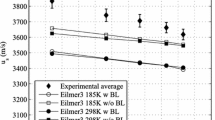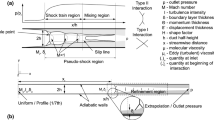Abstract
Large-scale free-piston driven expansion tubes have uniquely high total pressure capabilities which make them an important resource for development of access-to-space scramjet engine technology. However, many aspects of their operation are complex, and their test flows are fundamentally unsteady and difficult to measure. While computational fluid dynamics methods provide an important tool for quantifying these flows, these calculations become very expensive with increasing facility size and therefore have to be carefully constructed to ensure sufficient accuracy is achieved within feasible computational times. This study examines modelling strategies for a Mach 10 scramjet test condition developed for The University of Queensland’s X3 facility. The present paper outlines the challenges associated with test flow reconstruction, describes the experimental set-up for the X3 experiments, and then details the development of an experimentally tuned quasi-one-dimensional CFD model of the full facility. The 1-D model, which accurately captures longitudinal wave processes, is used to calculate the transient flow history in the shock tube. This becomes the inflow to a higher-fidelity 2-D axisymmetric simulation of the downstream facility, detailed in the Part 2 companion paper, leading to a validated, fully defined nozzle exit test flow.



Adapted from [16]

Adapted from [4]




Adapted from [17]










Similar content being viewed by others
References
Morgan, R.: Development of X3, a superorbital expansion tube. In: AIAA 38th Aerospace Sciences Meeting and Exhibit, 10–13 January, Reno, NV, AIAA Paper 2000-558 (2000). https://doi.org/10.2514/6.2000-558
Ponce, J.S.: Scramjet testing at high total pressure. PhD Thesis. School of Mechanical and Mining Engineering, The University of Queensland, St Lucia, Australia (2016). https://doi.org/10.14264/uql.2016.71
Toniato, P., Gildfind, D., Jacobs, P., Morgan, R.: Current progress of the development of a Mach 12 scramjet operating condition in the X3 expansion tube. In: The 20th Australasian Fluid Mechanics Conference, 5–8 December, Perth, Australia (2016)
Gildfind, D., Sancho, J., Morgan, R.: High Mach number scramjet test flows in the X3 expansion tube. In: Bonazza, R., Ranjan, D. (eds.) 29th International Symposium on Shock Waves 1, vol. 1, pp. 373–378. Springer, Dordrecht (2015). https://doi.org/10.1007/978-3-319-16835-7_58
Gildfind, D., Morgan, R., McGilvray, M., Jacobs, P.: Production of high Mach number scramjet flow conditions in an expansion tube. AIAA J. 52(1), 162–177 (2014). https://doi.org/10.2514/1.J052383
Gildfind, D., Morgan, R., Jacobs, P.: Expansion tubes in Australia. In: Igra, O., Seiler F. (eds.) Experimental Methods of Shock Wave Research, vol. 4, Chap. 1, pp. 399–431. Springer, Basel (2016). https://doi.org/10.1007/978-3-319-23745-9_13
Gildind, D., James, C., Toniato, P., Morgan, R.: Performance considerations for expansion tube operation with a shock-heated secondary driver. J. Fluid Mech. 777, 364–407 (2015). https://doi.org/10.1017/jfm.2015.349
Paull, A., Stalker, R.: Test flow disturbances in an expansion tube. J. Fluid Mech. 245, 493–521 (1992). https://doi.org/10.1017/S0022112092000569
Morgan, R.: Free-piston driven expansion tubes. In: Ben-Dor, G., Igra, O., Elperin, T. (eds.) Handbook of Shock Waves, vol. 1, Chap. 4.3, pp. 603–602. Elsevier, San Diego (2001). https://doi.org/10.1016/B978-012086430-0/50014-2
Miller, C.: Operational experience in the Langley expansion tube with various test gases, NASA Technical Memorandum 78637. NASA Langley Research Center, Hampton (1977)
Morgan, R., Stalker, R.: Double diaphragm driven free piston expansion tube. In: 18th International Symposium on Shock Waves, 21–26 July, Sendai, Japan (1991)
Jacobs, P.: Numerical simulation of transient hypervelocity flow in an expansion tube. Comput. Fluids 23(1), 77–101 (1992). https://doi.org/10.1016/0045-7930(94)90028-0
Neely, A., Morgan, R.: The superorbital expansion tube concept, experiment and analysis. Aeronaut. J. 98, 97–105 (1994). https://doi.org/10.1017/S0001924000050107
Chan, W., Smart, M., Jacobs, P.: Experimental validation of the T4 Mach 7.0 nozzle. Technical Report 2014/14. School of Mechanical and Mining Engineering, The University of Queensland, St Lucia (2014)
Hannemann, K., Karl, S., Schramm, J., Steelant, J.: Methodology of a combined ground based testing and numerical modelling analysis of supersonic combustion flow paths. Shock Waves 20, 353–366 (2010). https://doi.org/10.1007/s00193-010-0269-8
Gildfind, D., Morgan, R., Sancho, J.: Design and commissioning of a new lightweight piston for the X3 expansion tube. In: Bonazza, R., Ranjan, D. (eds.) 29th International Symposium on Shock Waves 1, vol. 1, pp. 367–372. Springer, Dordrecht (2015). https://doi.org/10.1007/978-3-319-16835-7_57
Gildfind, D.: Development of high total pressure scramjet flow conditions using the X2 expansion tube. PhD Thesis. School of Mechanical and Mining Engineering, The University of Queensland, St Lucia (2012)
Gordon, S., McBride, B.: Computer program for complex chemical equilibrium compositions and applications, NASA RP-1311. NASA Lewis Research Center, Cleveland (1994)
Pinckney, S.: A short static-pressure probe design for supersonic flow, NASA TN D-7978. NASA Langley Research Center, Hampton (1975)
Gildfind, D.E., Jacobs, P.A., Morgan, R.G., Chan, W.Y.K., Gollan, R.J.: Scramjet test flow reconstruction for a large-scale expansion tube, Part 2: hybrid CFD analysis. Shock Waves. https://doi.org/10.1007/s00193-017-0786-9
PCB Piezotronics Inc.: Product specification for PCB(R) 112A22 ICP(R) pressure sensor. https://www.pcb.com/products.aspx?m=112A22. Downloaded 21 Jan 2017
Kulite Semiconductor Products, Inc.: Product specification for Kulite(R) XTEL-190 (M) series pressure sensor. www.kulite.com/docs/products/XTEL-190.pdf. Downloaded 21 Jan 2017
Gollan, R., Jacobs, P.: About the formulation, verification and validation of the hypersonic flow solver Eilmer. Int. J. Numer. Methods Fluids 73, 19–57 (2013). https://doi.org/10.1002/fld.3790
Jacobs, P.: Quasi-one-dimensional modeling of a free-piston shock tunnel. AIAA J. 32(1), 137–145 (1994). https://doi.org/10.2514/3.11961
Mirels, H.: Test time in low-pressure shock tubes. Phys. Fluids 6(9), 1201–1214 (1963). https://doi.org/10.1063/1.1706887
Mirels, H.: Shock tube test time limitation due to turbulent-wall boundary layer. AIAA J. 2(1), 84–93 (1963). https://doi.org/10.2514/3.2218
Wendt, M., Macrossan, M., Jacobs, P., Mee, D.: Pilot study for a rarefied hypervelocity test facility. In: 13th Australasian Fluid Mechanics Conference, 13–18 December, Monash University, Melbourne, Australia (1998)
Wheatley, V., Chiu, H., Jacobs, P., Macrossan, M., Mee, D., Morgan, R.: Rarefied, superorbital flows in an expansion tube. J. Numer. Methods Heat Fluid Flow 14(4), 512–537 (2004). https://doi.org/10.1108/09615530410532277
Jacobs, P., Silvester, T., Morgan, R., Scott, M., Gollan, R., McIntyre, T.: Superorbital expansion tube operation: estimates of flow conditions via numerical simulation. In: 43rd AIAA Aerospace Sciences Meeting and Exhibit, 10–13 January, Reno, Nevada, AIAA Paper 2005-0694 (2005). https://doi.org/10.2514/6.2005-694
Morgan, R., McIntyre, T., Jacobs, P., Buttsworth, D., Macrossan, M., Gollan, R., Capra, B., Brandis, A., Potter, D., Eichmann, T., Jacobs, C., McGilvray, M., van Diem, D., Scott, M.: Impulse facility simulation of hypervelocity radiating flows. In: Wilson, A. (ed.) Proceedings of the 2nd International Workshop on Radiation of High Temperature Gases in Atmospheric Entry. ESA Publications, Noordwijk (2006)
Potter, D., Gollan, R., Eichmann, T., McIntyre, T., Morgan, R., Jacobs, P.: Simulation of CO\(_2\)-N\(_2\) expansion tunnel flows for the study of radiating shock layers. In: 6th AIAA Aerospace Sciences Meeting and Exhibit, 7–10 January, Reno, Nevada, AIAA Paper 2008-1280 (2008). https://doi.org/10.2514/6.2008-1280
Gildfind, D., Morgan, R., McGilvray, M., Jacobs, P., Stalker, R., Eichmann, T.: Free-piston driver optimisation for simulation of high Mach number scramjet flow conditions. Shock Waves 21(6), 559–572 (2011). https://doi.org/10.1007/s00193-011-0336-9
The compressible-flow CFD project. The University of Queensland, St Lucia. http://cfcfd.mechmining.uq.edu.au
Jacobs, P.: An approximate Riemann solver for hypervelocity flows. AIAA J. 30(10), 2558–2561 (1992). https://doi.org/10.2514/3.11264
Jacobs, P.: Shock tube modelling with L1d. Research Report No. 13/98. School of Mechanical and Mining Engineering, The University of Queensland, St Lucia, Australia (1998)
Parekh, V., Gildfind, D., Lewis, S., James, C.: X3 expansion tube driver gas spectroscopy and temperature measurements. In: AIAA Australian-Asia Regional Student Conference. American Institute of Aeronautics and Astronautics (2015)
Mundt, C., Boyce, R., Jacobs, P., Hannemann, K.: Validation study of numerical simulations by comparison to measurements in piston-driven shock-tunnels. Aerosp. Sci. Technol. 11, 100–109 (2007). https://doi.org/10.1016/j.ast.2006.12.002
McGilvray, M., Austin, J., Sharma, M., Jacobs, P., Morgan, R.: Diagnostic modelling of an expansion tube operating condition. Shock Waves 19, 59–66 (2009). https://doi.org/10.1007/s00193-009-0187-9
Gildfind, D., James, C., Morgan, R.: Free-piston driver performance characterisation using experimental shock speeds through helium. Shock Waves 25(2), 169–176 (2015). https://doi.org/10.1007/s00193-015-0553-8
Sebacher, D.I., Guy, R.W.: Vibrational relaxation in expanding N\(_2\) and air, NASA TM X-71988. NASA Langley Research Center, Hampton (1974)
Acknowledgements
The authors wish to thank Frans De Beurs, Neil Duncan, and the EAIT Faculty Workshop, for technical assistance with X3; The Australian Research Council for support and funding; The Queensland Smart State Research Facilities Fund 2005 for support and funding; The Australian Space Research Program and UQ for their funding in support of the “Scramjet-based Access-to-Space Systems” (SCRAMSPACE) project; The UQ High Performance Computing (HPC) Support Group for supercomputing support; this work was supported by computational resources provided by the Australian Government through Raijin and Magnus under the National Computational Merit Allocation Scheme.
Author information
Authors and Affiliations
Corresponding author
Additional information
Communicated by Z. Jiang and A. Higgins.
Rights and permissions
About this article
Cite this article
Gildfind, D.E., Jacobs, P.A., Morgan, R.G. et al. Scramjet test flow reconstruction for a large-scale expansion tube, Part 1: quasi-one-dimensional modelling. Shock Waves 28, 877–897 (2018). https://doi.org/10.1007/s00193-017-0785-x
Received:
Revised:
Accepted:
Published:
Issue Date:
DOI: https://doi.org/10.1007/s00193-017-0785-x




